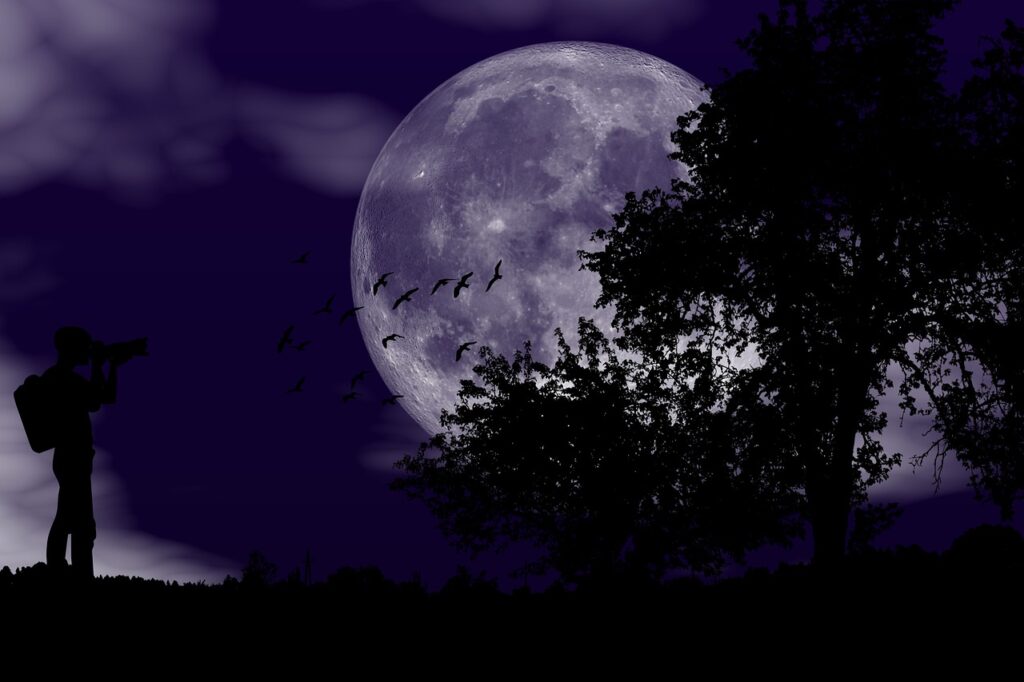| (18.16.12) 11.722 Northlight 85 (9.03 |

Length of time: 29-30 days
The separation of the Moon from the Yearly cycle
Pity the misunderstood Month.
The very origin of the English word “Month” is based on “Moon.”
Understandably, we are used to calendars with twelve months of the year. This extends far beyond the Gregorian and Julian calendars and their antecedents. Many of the earliest calendars were based on the lunar cycle. The oldest calendar ever found was discovered at Warren Field in Scotland, and is a lunar calendar built around 8000 BCE. As people began to understand the importance of the solar year, and discovered the gap between twelve lunar months and the solar year (354-355 days vs 365-366 days), the length of what had been called the “month” (based in English on the word “moon”) changed from an average of 29 1/2 days to 30 1/3 days, resulting in the difference of eleven to twelve days difference between the lunar year and the solar year.
If you think that shift is not a big deal, note that as of April 2022 CE, it is the year 1401 in the Solar Hijri Calendar, and 1443 in the Islamic Calendar. Both calendars have their Year One as 622 CE, based on the same significant event in the history of Islam. The Solar Hijri Calendar is, as its name implies, a solar calendar, with basically the same number of days per year as the Gregorian Calendar. The Islamic Calendar is based on 12 lunar months.
No wonder months are misunderstood.
There have been valiant attempts to integrate the lunar year and the solar year without changing the length of the month. Most lunisolar calendars do this by keeping the months tied to the lunar cycle and then adding a “leap” or thirteenth month to the calendar every two or three years. Probably one of the most well known cycles used to align the years with the months and leap months is the 19-year Metonic Cycle, which is used in the Hebrew Calendar and was use in the Babylonian Calendar, Runic Calendar, as well as older versions of the Chinese calendar. The chief disadvantage of such calendars is that the lengths of years can vary by as much as 30 days, which can complicate preparation for a planting season.
Other methods include having a number of uncounted days during a solar calendar year. The Sts’ailes (Chehalis) people in British Columbia, Canada, start the new year with the arrival of the Chinook salmon (usually in October), and then count ten lunar months, and leave the remaining days uncounted until the next arrival of Chinook salmon. There are some reports that a version of the pre-Julian Roman calendar employed similarly disorganized days between December and March.
The Earth Epic Calendar’s use of a lunar calendar
The Earth Epic Calendar has a separate lunar month- day cycle running completely independent of the year-quarter-day cycle, instead of trying to combine the lunar and solar calendar into a lunisolar calendar. For this reason, these lunar months are referred to as Moons to minimize possible confusion. This lunar date is a completely separate number. The date consists of the number of the month followed by the two-digit number of the day. The date listed at the top of this page shows it as 9.03, meaning Moon 9, Day 3. In formal expressions it can be put at the end of the date expression, or can be simply expressed as 11.722.09.03.
The lunar date has a left parenthesis preceding it, because, well, it’s essentially moon-shaped. A very thin crescent moon at that.
The first day of every new month is 0, and it is always timed with what day it is when the new moon arrives during UTC (Coordinated Universal Time). The new moon arrives simultaneously at all locations on Earth, but that also means that in some areas it will be a earlier day than at the Greenwich Meridian or sometimes it will land on a day later than the Greenwich Meridian.
The lunar month for the new year actually starts at the last new moon of the previous year. The number of that last moon is either 12 or 13, depending on when the first new moon of that year was. So if it’s the last new moon of the year, the moon day will count up to the day before the new year–the last day of Westcrossing. Then when the date crosses into Southlight 0 and a new year, the day number will continue to go up from the previous day, but the month number will now be 0, and will remain that way until the first new moon of the year, when the month number will be 1.
Many cultures have names for these moons. Using the cultural names instead is perfectly for the Earth Epic Calendar. So if people want to refer to Moon 9 as the Harvest Moon, they are perfectly free to write the date as Harvest Moon 3.
Rationale
Why track lunar months? Both scientific and anecdotal evidence show the Moon having a profound influence on the Earth. Earth’s Moon isn’t the biggest satellite in the Solar System, but it’s largest in size proportionately compared to the planet it orbits. We know that the Moon controls the tides of the oceans. Many people have also speculated that since human beings and most other living things are mostly made up of water, the Moon’s orbit would also have an impact on us as well. In any case, many people notice that things often seem a bit more chaotic during full moons.
<— go back to the Quarter page